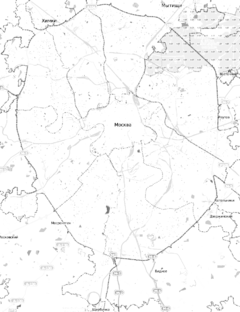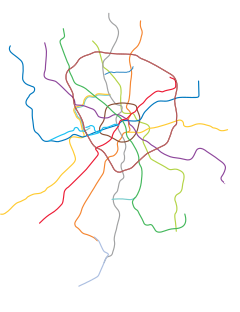Dinamo (Moscow Metro)
Dinamo (Russian: Дина́мо) is a Moscow Metro station on the Zamoskvoretskaya line. It opened on 11 September 1938 as part of the second stage of the system.[1] It was named for the former Dinamo Stadium, the home stadium of FC Dynamo Moscow. Passengers may make out-of-station transfers to the Bolshaya Koltsevaya and Kalininsko-Solntsevskaya lines via Petrovsky Park station.
Location
Dinamo is under Leningradsky Avenue in the Aeroport District of Moscow near Petrovsky Park and the Petrovsky Palace. The future VTB Arena is being built on the same site and dinamo stadium adjacent to the station.
Design and Layout
The station is situated at a depth of 39.6 metres (130 ft) and follows a tri-vaulted deep-level pylon design. Designed by Ya. Likhtenberg and Yury Revkovsky, the station features a sport-themed decoration with bas-reliefs designed by Ye. Yason-Manzer depicting sportsmen in various practices in the vestibules and the central hall.
The pylons, faced with red tagilian marble and onyx have porcelain medallions also showing sportsmen. The walls are faced with onyx, white and grey marble, neatly tiled together. The floor is revetted with black marble, although the platforms were initially covered with asphalt.
There are two identical vestibules, each on the northern side of the Leningradsky Avenue, and the architect for the vestibules was Dmitry Chechulin.
The city is building an underground walkway between Dinamo and Petrovsky Park stations that will ease transfers between the stations. That walkway could open in late 2018.[2]
Scientific Use
In 1940, physicists Georgy Flyorov and Konstantin Petrzhak used the station for their observations of the decay of uranium. The depth of the station reduced the potential effect of cosmic rays in their work. Working at night, the pair discovered spontaneous fission.[1]
Gallery
-
Pylon view
-
Platform view
References
- ^ a b "Станция метро "Динамо"" (in Russian). City of Moscow. Retrieved 2018-03-04.
- ^ "Переход между станциями метро "Динамо" и "Петровский парк" построят через год" (in Russian). Moscow Complex for Construction and Urban Development. 2017-09-18.





